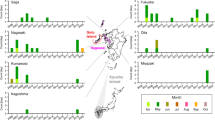Abstract
Ambient concentrations of photochemical oxidants (Ox) averaged throughout all ambient monitoring stations in Japan have increased slightly during the past two decades despite decreasing emissions of oxidant precursors such as NOx and hydrocarbons. In the Kanto area of Japan, which is heavily populated and industrialized, Ox concentrations are often high, especially in late spring and summer, and a photochemical smog warning is frequently issued. Although the north Kanto area is about 150 km from the southern metropolitan area, and, moreover, local emissions of precursors are limited because of its agricultural and forested character, high Ox concentration levels (>120 ppbv (1-h average)) are often observed there. We analyzed the relationship between the occurrence of high Ox concentrations in the north Kanto and meteorological conditions. By combining the regional wind pattern and the presence of the inversion layer in the atmospheric boundary layer, we identified five distinct meteorological patterns. High Ox concentrations in the north Kanto area were associated with a southerly extended sea breeze accompanied by a subsidence inversion layer. We inferred that the transport of Ox from the southern urban area by southerly winds and restricted dispersion below the inversion layer can lead to high Ox concentrations in the north Kanto area. This meteorological condition is associated with the presence of a high pressure system centered in the southeastern or eastern sector offshore of the Kanto area. Thus, Ox concentrations in the north Kanto area, where emissions of precursors are relatively low, can easily increase to very high levels under favorable meteorological conditions.













Similar content being viewed by others
References
Akimoto, H., Nakane, H., & Matsumoto, Y. (1994). The chemistry of oxidant generation: Tropospheric ozone increase in Japan. In J. D. Calvert (Ed.), Chemistry of the atmosphere: The impact on global change (pp. 261–273). Oxford: Blackwell Scientific Publications.
Atkinson, R. (2000). Atmospheric chemistry of VOCs and NOx. Atmospheric Environment, 34, 2063–2101.
Dockery, D. E., Pope, C. A., Xu, X., Spengler, J. D., Ware, J. H., Fay, M. E., et al. (1993). An association between air pollution and mortality in six U.S. cities. The New England Journal of Medicine, 329, 1753–1759.
Hayasaki, M., Ohara, T., Kurokawa, J., Uno, I., & Shimizu, A. (2008). Episodic pollution of photochemical ozone during 8–9 May 2007 over Japan: Observational data analyses. Journal of Japan Society for Atmosphere Environment, 43, 225–237 (in Japanese with English abstract).
Jacob, J. J. (1999). Introduction to atmospheric chemistry. Princeton, New Jersey: Princeton University Press.
Kobayashi, K. (1999). Assessing the impacts of tropospheric ozone on agricultural production. Journal of Japan Society for Atmosphere Environment, 34, 162–175 (in Japanese with English abstract).
Krupa, S. V., & Manning, W. J. (1988). Atmospheric ozone: Formation and effects on vegetation. Environmental Pollution, 50, 101–137.
Kurita, H., & Ueda, H. (1986). Meteorological conditions for long range transport under light gradient winds. Atmospheric Environment, 20, 687–694.
Naja, M., & Akimoto, H. (2004). Contribution of regional pollution and long-range transport to the Asia-Pacific region: Analysis of long-term ozonesonde. Journal of Geophysical Research (D), 109, D21306.
National Research Council (NRC). (1991). Rethinking the ozone problem in urban and regional air pollution, committee on tropospheric ozone formation and measurement, 1 what is the problem? (pp. 19–40). Washington: National Academy Press.
Ohara, T. (2001). Numerical simulation of the springtime trans-boundary air pollution in East Asia. Water, Air, and Soil Pollution, 130, 295–300.
Ohara, T., & Sakata, T. (2003). Long-term variation of photochemical oxidants over Japan. Journal of Japan Society for Atmosphere Environment, 38, 47–54 (in Japanese with English abstract).
Ohara, T., Uno, I., Kurokawa, J., Hayasaki, M., & Shimizu, A. (2008). Episodic pollution of photochemical ozone during 8–9 May 2007 over Japan—overview. Journal of Japan Society for Atmosphere Environment, 43, 198–208 (in Japanese with English abstract).
Pochanart, P., Akimoto, H., Kinjo, Y., & Tanimoto, H. (2002). Surface ozone at four remote island sites and the preliminary assessment of exceedances of its critical level in Japan. Atmospheric Environment, 36, 4235–4250.
Seinfeld, J. H., & Pandis, S. N. (1998). Atmospheric chemistry and physics. New York: Wiley.
Wakamatsu, S., Ohara, T., & Uno, I. (1996). Recent trends in precursor concentrations and oxidant distributions in the Tokyo and Osaka areas. Atmospheric Environment, 30, 715–721.
Wakamatsu, S., Uno, I., Ohara, T., & Schere, K. L. (1999). A Study of the relationship between photochemical ozone and its precursor emissions of nitrogen oxides and hydrocarbons in Tokyo and surrounding areas. Atmospheric Environment, 33, 3097–3108.
Yoshikado, H. (1990). Vertical structure of the sea breeze penetrating through a large urban complex. Journal of Applied Meteorology, 29, 878–891.
Yoshikado, H. (2004). One possible factor causing recent trend of photochemical oxidants. Journal of Japan Society for Atmosphere Environment, 39, 188–199 (in Japanese with English abstract).
Yoshikado, H., Tsubaki, T., & Sasaki, K. (2006). Feasibility of a method simulating long-term average concentration of pollutants based on a mesoscale meteorological model, (II) application to assessment of high-level local ozone. Journal of Japan Society for Atmosphere Environment, 41, 15–26 (in Japanese with English abstract).
Acknowledgments
The authors express their thanks to the National Institute for Environmental Studies (NIES) for providing the data set of 1-h ambient pollutant concentrations, the Japan Meteorological Agency (JMA) for providing the AMeDAS measurement data, and the Department of Atmospheric Science of the University of Wyoming for providing the aerological soundings data.
This work was supported in part by Grants-in-Aid from Saitama University.
Author information
Authors and Affiliations
Corresponding author
Rights and permissions
About this article
Cite this article
Hosoi, S., Yoshikado, H., Gaidajis, G. et al. Study of the Relationship between Elevated Concentrations of Photochemical Oxidants and Prevailing Meteorological Conditions in the North Kanto Area, Japan. Water Air Soil Pollut 215, 105–116 (2011). https://doi.org/10.1007/s11270-010-0462-5
Received:
Accepted:
Published:
Issue Date:
DOI: https://doi.org/10.1007/s11270-010-0462-5




